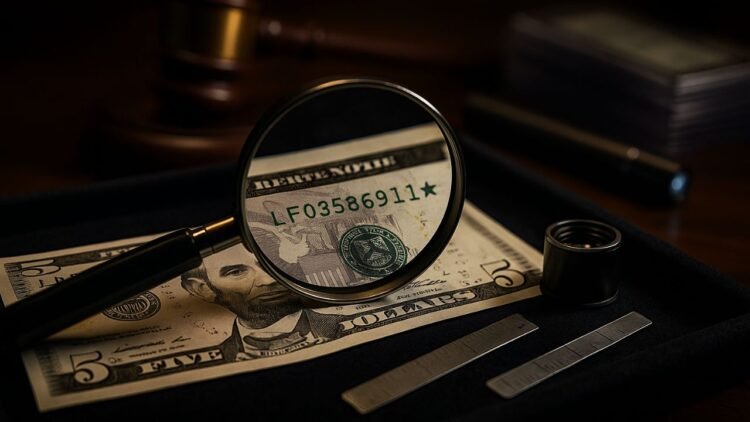If you’re holding a $5 bill, don’t rush to spend it. Some notes with special serial numbers, scarce star notes, or dramatic printing errors have sold for five-figure amounts—and standout pieces are often discussed in the $66,000 range.
The key is knowing what to look for, how to judge condition, and when to seek professional grading so you can price your note realistically.
What Makes A $5 Bill Valuable
Three pillars drive value: Rarity, Demand, and Condition. Collectors pay premiums for notes that are hard to find, visually striking, and preserved in uncirculated or near-uncirculated shape.
Even circulated notes can be valuable if they feature the right serial number pattern, a star, or a major printing error.
Fancy Serial Numbers To Watch
Collectors love “fancy” serial numbers because they’re visually unique and statistically scarce:
- Ladders: 12345678 or 87654321
- Radars (palindromes): 12344321
- Repeaters: 12121212 or 45454545
- Solids: 11111111, 88888888
- Low Numbers: 00000001–00000100
- Birthday/Anniversary: e.g., 19991231
In high grade, these can move from modest premiums to hundreds or even thousands depending on eye appeal and scarcity.
Why Star Notes Matter
A star (★) after the serial number means the bill is a replacement note printed to substitute a misprinted sheet. Some low-print-run star notes are significantly scarcer than regular runs.
On certain series and districts, desirable star notes can jump from face value to hundreds—more if paired with a fancy serial or superb condition.
Errors That Command Big Money
The biggest jackpots come from obvious, dramatic printing errors:
- Double-Denomination: A $5 face paired with a $10 back is the classic “wow” error often talked about at five-figure levels.
- Mismatched Or Missing Serials: Top and bottom numbers differ, or a serial is missing on one side.
- Inverted Overprints: Seals/serials printed upside-down.
- Major Offsets & Foldovers: Ink transferred where it shouldn’t, or paper folded during printing.
These are rare, easy to see with the naked eye, and highly sought after—exactly the kind of notes that can fuel $10,000–$66,000 talk when grade and eye appeal are exceptional.
Quick Reference – What To Look For
| Feature | What It Looks Like | Typical Value Potential* | Pro Tip |
|---|---|---|---|
| Fancy Serial Numbers | Ladders, radars, solids, repeaters, low numbers | $50–$1,500+ (higher in top grades) | Keep only crisp examples; stains and folds cut value fast. |
| Star Notes (★) | Star after the last digit | Over face to hundreds+ | Check the series and run size; low runs bring premiums. |
| Double-Denomination Error | $5 front, $10 back (or vice-versa) | $20,000–$66,000 (elite cases) | Authenticate and grade; fakes exist. |
| Mismatched/Missing Serials | Top and bottom serials differ or one is absent | Hundreds–thousands | Photograph clearly and compare both positions. |
| Inverted/Offset/ Foldover | Upside-down seals, shifted prints, or fold captured in ink | Hundreds–thousands | The more dramatic and centered, the better. |
*Actual prices depend on series, district, grade, and market demand.
How To Check Your $5 Bill (Step-By-Step)
- Inspect The Serials: Look for ladders, radars, solids, repeaters, low numbers, or meaningful dates.
- Look For The Star: A ★ after the serial can mean a scarcer replacement note—especially valuable in low-print runs.
- Flip And Compare: Make sure the back design matches the denomination and check for inverted or misplaced seals and serials.
- Judge Condition: Crisp Uncirculated (CU) or About Uncirculated (AU) notes command huge premiums over worn examples.
- Authenticate & Grade: If you suspect a winner, submit to a respected third-party grading service (e.g., PMG or PCGS Banknote). A certified grade and error attribution boosts buyer confidence and resale value.
- Set Expectations: While talk of $66,000 grabs headlines, most valuable $5s trade for hundreds to low five-figures. Exceptional rarity, dramatic errors, and top grades are what push prices to the stratosphere.
Your $5 bill could be a hidden treasure. Focus on serial number patterns, star notes with low runs, and big, eye-visible printing errors.
Confirm the series, evaluate condition, and consider professional grading to unlock full value.
Although only the rarest, best-preserved examples approach the much-talked-about $66,000 mark, many collectors routinely pay strong prices for the right combination of rarity, demand, and condition—meaning your next great find could be hiding in plain sight.
FAQs
Are Circulated Notes Still Valuable?
Yes. Strong fancy serials, scarce star notes, and major errors can bring hundreds or more even with light circulation, though uncirculated examples bring the highest premiums.
Which Error Brings The Most Money?
The double-denomination ($5 front with a $10 back) is among the most desirable and is often associated with five-figure results.
Should I Clean Or Flatten My Note?
No. Cleaning, pressing, or “fixing” a note can permanently reduce value. Keep it protected in a currency sleeve and seek professional grading if it appears special.
